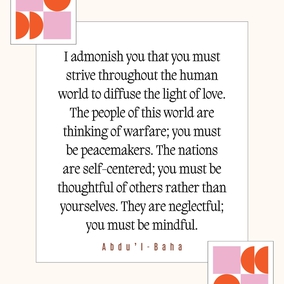The views expressed in our content reflect individual perspectives and do not represent the authoritative views of the Baha'i Faith.
When a new Divine messenger appears, the revelation he or she brings may initially seem concise, straightforward, and singular – but over time it always proves much more layered and complex.
In the most recent installment of this series, Part 70, “Baha’u’llah’s Nine Modes of Discourse – Including Prophecies,” I proposed a typology, or classification system, of Baha’u’llah’s writings, based on Baha’u’llah’s own statement in his Tablet of the Temple (Suriy-i-Haykal): “We have revealed Our verses in nine different modes.”
Of course, this raises a question: what are Baha’u’llah’s “nine modes” of revelation?
RELATED: Baha’u’llah’s “Gleanings”: A Gift to Humanity
Baha’u’llah, when asked about it, advised the questioner to: “… meditate thereon, that he may attain his goal.” (provisional translation by Adib Masumian). So Baha’u’llah actually encouraged reflection on this question, inviting our investigation as to what these nine modes may be.
Of course, Baha’is believe that Baha’u’llah’s writings are divinely-inspired revelations from God. That’s why, in my introductory book, Baha’i Faith: The Basics, a discussion of these nine differing modes appears in Chapter 5, “Scripture and Authoritative Writings: Baha’i Sacred Texts and Inspired Guidance.”
My categorization of these nine modes is based, in large part, on three descriptive passages by Shoghi Effendi in his book God Passes By. Originally published in 1944, that important volume highlights the first 100 years of Baha’i history. As a disclaimer, readers should know that my proposed typology of the major styles – the nine modes of Baha’u’llah’s writings – is my own, even though based on statements by Shoghi Effendi, the Guardian of the Baha’i Faith. The classifications I present are not authoritative, but I hope they will be useful.
My identification of these nine modes is based largely on this single paragraph from page 220 of God Passes By, with the numbers and themes of each of the proposed nine modes in brackets provided by me. Here, Shoghi Effendi, in condensed form, panoramically maps out in broad scope the contents of Baha’u’llah’s last book, Epistle to the Son of the Wolf:
With this book, revealed about one year prior to His ascension, the prodigious achievement as author of a hundred volumes, repositories of the priceless pearls of His Revelation, may be said to have practically terminated—volumes replete with unnumbered [3] [ethical] exhortations, revolutionizing [6] principles, world-shaping [5] laws and ordinances, dire warnings and portentous [7] prophecies, with soul-uplifting [9] prayers and meditations, illuminating [2] [doctrinal] commentaries and interpretations, impassioned [8] discourses and homilies, all interspersed with either [4] [proclamation] addresses or references to kings, to emperors and to ministers, of both the East and the West, to ecclesiastics of divers denominations, and to leaders in the intellectual, political, literary, [1] mystical, commercial and humanitarian spheres of human activity.
As further proof of concept, I would like to mention a prior, alternative and more elaborate classification system, proposed by the eminent Baha’i scholar Nosratollah Mohammadhosseini from his Concordance of the Most Holy Book:
1. The Station and Voice of Divine Commandments.
2. The Station and Voice of Servitude and Prayer.
3. The Station and Voice of Interpretation of the Divine Words of Former Religious Dispensations.
4. The Station and Voice of the Enforcement and Abrogation of Religious Law.
5. The Station and Voice of Mystical Expositions.
6. The Station and Voice of Political Pronouncements and Orders to the Sovereigns of the Earth.
7. The Station and Voice of Pronouncements on Science, Philosophy, Medicine, Alchemy, Unraveling the Mysteries of Creation, and the Like.
8. The Station and Voice of Pronouncements on Education, Training, and Morality.
9. The Station and Voice of Pronouncements on Society, Universal Peace, the Oneness of the World, and the Singleness of Truth.
Here, it seems, there is close agreement between my classifications and Dr. Mohammadhosseini’s categories, which appear to be a revision of Jinab-i-Fadil’s original list (see Part 70). Both of those lists are in close approximation and in the same order, thus giving readers three alternative approaches. These three lists of Baha’u’llah’s nine modes of revelation give us a way to not only categorize the Baha’i writings, but to help us begin to sort, classify, and comprehend them. Let’s look at some actual examples.
1. Mystical Compositions
Baha’u’llah’s well-known volume The Seven Valleys best fits the term “mystical compositions.” In God Passes By, Shoghi Effendi described The Seven Valleys as: “a treatise that may well be regarded as His greatest mystical composition, designated as the ‘Seven Valleys’”.
This classification of sacred texts compares favorably with Jinab-i-Fadil’s “Mystical Writings” and Dr. Mohammadhosseini’s “The Station and Voice of Mystical Expositions.” So there is consensus on the term “mystical” here. However, I’ve placed this category first in this list of “nine modes,” since Baha’u’llah’s earliest writings were largely, although not exclusively, mystical in nature. Baha’u’llah himself indicated, in this provisional translation from Nader Saiedi, that his proclamation was delivered in three successive stages:
Behold and observe! This is the finger of might by which the heaven of vain imaginings was indeed cleft asunder. Incline thine ear and hear! This is the voice of My pen which was raised among mystics, then divines, and then kings and rulers.
2. Doctrinal Writings
The best example in this category, Baha’u’llah’s The Kitab-i-Iqan: The Book of Certitude, clearly shows that these “doctrinal writings” are primarily about Baha’i beliefs and matters of faith. Shoghi Effendi, in referring both to this work and another book, The Hidden Words, describes these as “… two outstanding contributions to the world’s religious literature, occupying respectively, positions of unsurpassed preeminence among the doctrinal and ethical writings of the Author of the Baha’i Dispensation.”
Here, Jinab-i-Fadil’s “Tablets with the tone of command and authority” (his list #1) and Dr. Mohammadhosseini’s “The Station and Voice of Divine Commandments” (his list #1) appear to correspond more to my new category #6, “Fundamental Tenets and Principles.” Since these texts are propounded in a voice of power and authority, the term “doctrinal” is favored, based on Shoghi Effendi’s own designation.
3. Ethical Writings
Probably the best example of Baha’u’llah’s ethical writings is his celebrated collection of pithy sayings, or aphorisms, known as The Hidden Words. This group of writings focuses on individual moral and spiritual behavior as distinct from institutional and social norms. Here, the term “ethical” used by Shoghi Effendi seems more concise and descriptive than Jinab-i-Fadil’s “Tablets exhorting men to education, goodly character and divine virtues” (his list #8) and Dr. Mohammadhosseini’s “The Station and Voice of Pronouncements on Education, Training, and Morality” (his list #8).
4. Proclamation
The Summons of the Lord of Hosts, a compilation of tablets and letters to the kings and rulers of the world which Baha’u’llah revealed in Adrianople/Edirne and Akka/Acre, best fits the “Proclamation” category, based on Shoghi Effendi’s precedent. Here, Jinab-i-Fadil’s “Tablets concerning matters of government and world order, and those addressed to the kings” (his list #6) and Dr. Mohammadhosseini’s “The Station and Voice of Political Pronouncements and Orders to the Sovereigns of the Earth” (his list #6) more or less express the same class of writings.
5. Laws and Ordinances
Baha’u’llah revealed his laws and ordinances in The Kitab-i-Aqdas: The Most Holy Book, revealed in 1873 in Akka. Here, Shoghi Effendi uses the phrase, “laws and ordinances, as does Jinab-i-Fadil’s “Writings in which laws and ordinances have been enjoined for this age and laws of the past abrogated” (his list #4). Dr. Mohammadhosseini’s “The Station and Voice of the Enforcement and Abrogation of Religious Law” (his list #4) is also expressive, but not concise.
6. Fundamental Tenets and Principles
Baha’u’llah’s Tablets of Baha’u’llah Revealed after the Kitab-i-Aqdas, also published as Fountain of Wisdom: A Collection of Writings from Bahaʼu’llah, best represents this class of Baha’i sacred scriptures which are primarily about the major Baha’i social teachings, as articulated and advocated by Baha’u’llah.
Baha’is typically speak of the major Baha’i teachings as “Baha’i principles,” usually set forth in numerical list form, as Baha’u’llah and Abdu’l-Baha often did. These are distinct from “Doctrinal Writings,” which are primarily about Baha’i beliefs and matters of faith, and also distinct from “Discourses,” which are about various topics, most often in Baha’u’llah’s answers to questions.
Here, Jinab-i-Fadil’s “Tablets dealing with social teachings” (his list #9) and Dr. Mohammadhosseini’s “The Station and Voice of Pronouncements on Society, Universal Peace, the Oneness of the World, and the Singleness of Truth” (his list #9) are in basic agreement with “fundamental tenets and principles” – or “Principles,” in short.
7. Prophecies
One of the best examples in this category are Baha’u’llah’s famous words to Cambridge Professor Edward Granville Browne on April 16, 1890.
However, Jinab-i-Fadil’s “Writings dealing with interpretation of the old Scriptures, religious beliefs and doctrines of the past” (his list #3) and Dr. Mohammadhosseini’s “The Station and Voice of Interpretation of the Divine Words of Former Religious Dispensations” (his list #3) appear not to include the Baha’u’llah’s own “dire warnings and portentous prophecies” as mentioned by Shoghi Effendi in God Passes By.
Here, there may be some overlap with Baha’u’llah’s “Doctrinal Writings” (my category #2), considering Shoghi Effendi’s identification of The Book of Certitude, which focuses primarily on the symbolic and spiritual interpretation of past prophecies, as Baha’u’llah’s preeminent “doctrinal” text – and also some overlap with “Proclamation” (my category #4), in which Baha’u’llah announces his prophetic mission, in the present, as the fulfillment of past prophecies. Thus “Prophecies” can include, in scope, prophecies past, present, and future.
RELATED: Baha’u’llah’s Book of Certitude: Illuminating Spiritual Wisdom
8. Discourses
The Tabernacle of Unity, compiled and first published by the Baha’i World Centre in 2006, includes Baha’u’llah’s expositions on a wide array of topics. These discourses are largely topical and explanatory in nature, distinct from “Doctrinal Writings,” primarily about Baha’i beliefs; and also distinct from “Fundamental Tenets and Principles,” primarily about social teachings.
Jinab-i-Fadil’s “Tablets dealing with subjects of learning and knowledge, divine philosophy, mysteries of creation, medicine, alchemy, etc.” (his list #7) and Dr. Mohammadhosseini’s “The Station and Voice of Pronouncements on Science, Philosophy, Medicine, Alchemy, Unraveling the Mysteries of Creation, and the Like” (his list #7) are apropos but not very concise descriptions of this category.
9. Prayers and Meditations
The best example in this category of Baha’u’llah’s writings is his Prayers and Meditations, compiled and translated by Shoghi Effendi and first published in 1938.
Jinab-i-Fadil’s “Those with the tone of servitude, meekness and supplication” (his list #2) is in close agreement and seems to be followed by Dr. Mohammadhosseini’s “The Station and Voice of Servitude and Prayer” (his list #2). That said, “Prayers and Meditations” is the preferred term for this category, as it was used by Shoghi Effendi.
These correspondences between lists of Baha’u’llah’s modes of revelation are approximate, with considerable overlap. In the next article in this series, we will focus on examples of each category in this “nine modes” model from Baha’u’llah’s last book, Epistle to the Son of the Wolf, as described by Shoghi Effendi.
Hopefully, this new attempt at categorizing the components of the vast Baha’i revelation will give seekers and Baha’is a way to approach the profound, fathomless ocean of Baha’u’llah’s writings.
















Comments
Sign in or create an account
Continue with Googleor